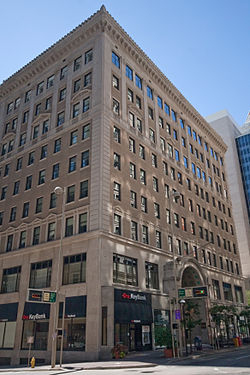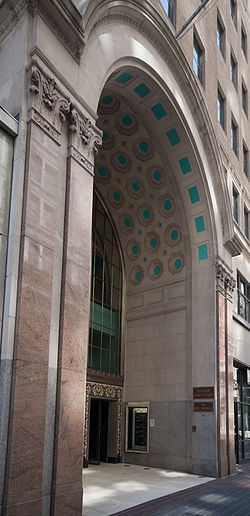- Dixie Terminal
-
The Dixie Terminal buildings in Cincinnati, Ohio were completed in 1921 and served as streetcar terminal, stock exchange and office building in downtown Cincinnati. They were designed by Cincinnati architect Frederick W. Garber's Garber & Woodward firm. [1] [2] The main building includes an "Adamesque barrel-vaulted concourse" and "Rookwood Architectural Faience entry arch".[3] The Rookwood tiles were manufactured by the local Rookwood Pottery Company.
Located at Fourth and Walnut Streets, the Terminal was constructed of reinforced concrete and finished in gray brick, Bedford limestone, and granite.[1] It includes two structures: the 4-story south building extending to Third Street, where streetcars entered and left, and the "handsome" 10-story north building, housing railroad ticket agencies, the Cincinnati Stock Exchange, administrative offices of the Cincinnati Street Railway Company, commercial offices and shops.[4]
A long and elaborate arcade runs through from main entrance through the building; shops were located alongside. The building included marble floors, Bottincino marble wainscot, metal trimmings, and "costly brightly decorated ceilings, with fanciful medallions showing little children riding on the backs of various animals".[4]
The terminal was used for bus service after streetcar service ceased in the 1950s.[1] Buses arriving from northern Kentucky crossed the Roebling Suspension Bridge and took ramps from the bridge into the terminal.[1] The ramps were removed and the bus service ceased using the terminal in 1998 .[1] The Cincinnati Stock Exchange closed its physical trading floor in 1976 after becoming an all electronic stock trading exchange but remained in the building until relocating from Cincinnati to Chicago in 1995. It has been renamed the National Stock Exchange". [1]
Ornament and decoration
Joseph Francis Beller is believed responsible for the original gold-leafing and the "frolicking" cherubs in the building. Beller had a studio at 1229 Hopkins Street in Cincinnati.[5]
References
- ^ a b c d e f Dixie Terminal Buildings Warmarking
- ^ [1] Cincinnati transit
- ^ http://daap.uc.edu/library/archcinci/7ingalls.html
- ^ a b Cincinnati: A Guide to the Queen City and Its Neighbors 1943, Tour 4, page 174
- ^ Terminal redux
Categories:- Buildings and structures in Cincinnati, Ohio
- Bus stations in Ohio
- Defunct Ohio railroads
- Stock exchanges in the United States
Wikimedia Foundation. 2010.


